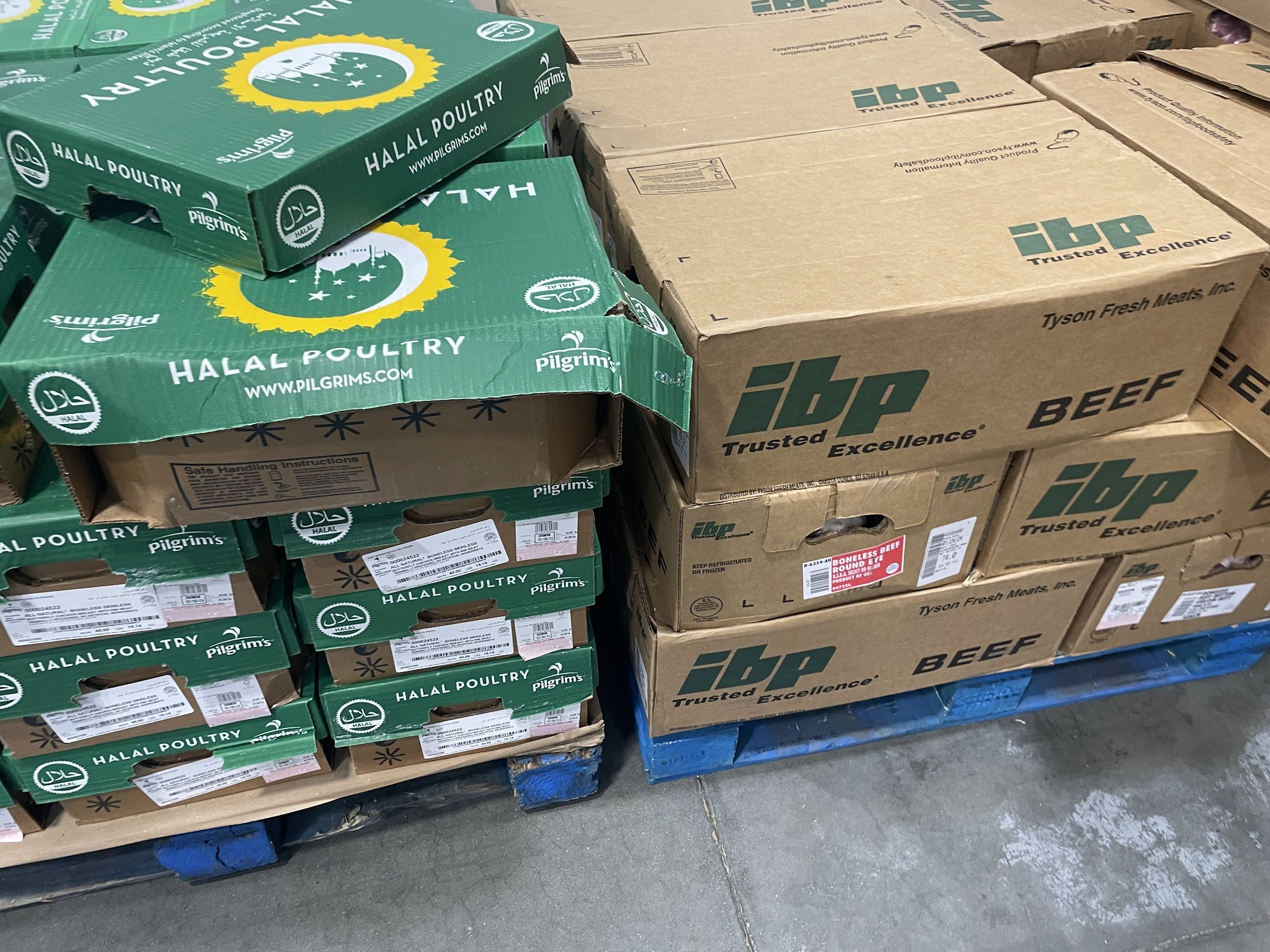Restaurants make minimal margin after labor, rents, and equipment costs are calculated. In Cologne, a restaurant stopped taking credit card because the 1-2% fee was too much. Economies of scale make it difficult for regular restaurants to survive, and of those that do, they are either high end or purchasing everything from wholesalers such as Costco Business Center, Restaurant Depot, or regional/cultural ones such as Yamasho.
Restaurants = Sysco
Most restaurants are just a wrapper around wholesalers, which are pretty bad in quality. The yellow coloring in fried rice is food coloring.
These wholesalers generally buy from large-scale factory farms. Factory farmed broiler chickens in battery arrangement are 50 cents a pound. I was walking around in Boston when someone pulled a cart of this “Halal chicken,” which I instantly recognized due to the green cover of the box. There’s no Costco Business Center around, so there must be a similar wholesaler nearby.

Because of this, I don’t enjoy eating at regular restaurants anymore. Most of them buy from wholesalers with industrial foods of dubious quality, and I know in price and quality I can source things much better. If I went to a restaurant, I would want to go to a highly rated one instead.
I’ve also started seeing numerous similar motifs in restaurants… the plastic busing cart from Costco, the common red and black fake lacquer stained bowl for Japanese food, blue and white porcelain style, and melamine plates. Both Harvard and Georgetown dining halls have soda machines much like that of a Costco food court.

As the amount of humans in agriculture decreases, it certainly makes sense that there is a corresponding increase in a lack of diversity of food sources unless individual gardening effort (German Schrebergarten or Japanese citizen farms) is taken.
Recipes
From this, it follows that recipes are outdated. Recipes originated in a time where food sources were geographically limited. They are the product of natural selection; the best recipes that have survived from a certain place and time. Given a modern food industrial system that makes many things available in advanced countries, recipes are no longer constrained by scope. I often find people making food by going to a grocery store, piffling around to find some random spices, throwing most things in the fridge (as opposed to a cellar or other custom storage unit), and shoving food (often pasta) around on a toxic, non-stick pan with vegetable oils. And that’s only if they are trying to cook rather than eating solely processed foods.
Since the industrial food system aims for homogenity it means that Costco, Whole Foods, Walmart, Lidl, Hmart, and other retailers will supply similar ingredients across the country, leading to a similar scope of products available. This is something I personally verified. Whole Foods in Atlanta is very similar to Whole Foods in Boston. Canary Islands Lidl has Swiss Gruyere of same manufacture and origin as that of Dresden Lidl. Recipes should then focus on foods available given a certain retailer. There could be the “Dollar General recipes” for those unable to drive in food deserts (a terrible, insufficient, and overpriced diet in almost all respsects), a “Walmart recipe,” and so on. It’s possible for someone to maintain their independence in the face of the industrial food systems. However, it requires active effort and a strong community, but it’s better than the fate of cheap and unhealthy calories and the destruction of knowledge and means of production.
Having the means of production such as the Amish will ensure your maintenance and dignity, even if it’s difficult work. To allow the modern food system in such as fried food restaurants, cheap carbohydrates, vegetable oils, alcohol, and so on leads to your destruction.
Though there exists a high correspondence between Hmart and “East Asian” food, it’s not wholly accurate to describe things as an ethnic supermarket. I think it makes the most sense to describe food as the industrial supply chain that originated it with certain cultural influences. For example, recipe from the German industrial food system with cultural association with Thai food. (Note: Thai food is like fast food, but less fried and healthier, in Germany)
National Standards, Competition, and the Future
And the distinction clearly matters because there are different national standards and regulations for food, such as the American one for the bleaching of wheat with chemicals. The cultural association with location used to be much stronger and self-describing. For example, a recipe from the American South local food system (1950s) for cornbread, collard greens, and so on. If you only buy locally, you could describe your recipes such as “recipe from the Anchorage local food system.” (In reality, this doesn’t exist anymore and the Inuit are obese because of the American industrial food system).
This was the end product of agricultural system development because economies of scale made it impossible for local farmers to compete. Though the government could have maintained their existence, without the shift of large amounts of people out of the agriculture sector, it would’ve been very difficult to compete in the manufacturing and technology sectors, leading to a country being weak (and possibly conquered). Gardening and farming are humbling acts, and it may be worthwhile for a country to cultivate such values in urban dwellers.
I hope not to be pigeonholed by cultural recipes but to be able to go to any supermarket and instantly know how to create a dish using fundamental principles of meats, vegetables, and so on. Any organization that is able to source foodstuffs and manufactures from the industrial food system in a non-generic and beneficial way will have a competitive advantage over those that pick the defaults. Due to labor and productivity reasons, there may be difficulty in sourcing everything locally, and it may not be a competitive advantage. Any country that improves their industrial food system will benefit greatly; any country that fails to do so risks the health of their nation, especially if they mistakenly supplement poisons into their foods in the hopes of fortifying nutrition.
Competition is sure to abound through human methods of competition without harm such as money, no different from a deer thrashing another deer’s antlers to maintain status hierarchies and the distribution of resources without harming the other. China pays around 1-2 dollars (I think AUD, but not sure) more for Australian lamb than other countries. Gulf countries also buy large amounts of Australian lamb. But the overall productivity of a region and the organization of groups of people will determine the resources they are able to acquire from the global marketplace of commodities such as gas and meats.